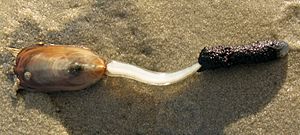Lingulata facts for kids
Quick facts for kids Lingulata |
|
|---|---|
 |
|
| Lingula anatina from Stradbroke Island, Australia. | |
| Scientific classification |
|
| Kingdom: | Animalia |
| Clade: | Lophophorata |
| Phylum: | Brachiopoda |
| Subphylum: | Linguliformea |
| Class: | Lingulata |
| Orders | |
|
|
Lingulata is a group of sea animals called brachiopods. They are some of the oldest brachiopods known. These amazing creatures have been around since the Cambrian period, which was about 541 to 485 million years ago.
What's really cool about Lingulata is how little they have changed. Their shape today is almost the same as it was millions of years ago! This makes them one of the most "conservative" animals in terms of how they look. For example, shells of living Lingulata found near Japan look nearly identical to ancient fossils from the Cambrian period.
What Lingulata Look Like
Lingulata have shells that are shaped like a tongue. This is where their name comes from, as "Lingulata" means "tongue" in Latin. They also have a long, flexible stalk called a pedicle. They use this stalk to dig into sand or mud at the bottom of the ocean.
These animals live in vertical burrows. Their front end faces up and sticks out a little from the mud. Inside their shells, they have a special feeding organ called a lophophore. Tiny hairs called cilia on the lophophore create currents. These currents bring food and oxygen into the animal. Lingulata also have a complete, J-shaped digestive system.
Their Unique Shells
Most shelled sea animals have shells made of calcium carbonate. But Lingulata are different! Their shells are made from a mix of calcium phosphate, protein, and chitin. Chitin is the same material found in the shells of insects and crabs.
Lingulata are known as "inarticulate brachiopods." This means their two shell halves don't have teeth or a hinge like many other shelled animals. Instead, strong muscles hold their shells together. Both halves of their shell are roughly the same size and shape.
The Ancient Lingula Genus
The genus Lingula is very special. It is the oldest known group of animals that still has living species today. This means that animals very similar to the Lingula we see now have been alive for hundreds of millions of years!
You can find Lingula mainly in the Indo-Pacific region. In places like Japan and Australia, people even harvest them to eat.
See also
 In Spanish: Lingulados para niños
In Spanish: Lingulados para niños

